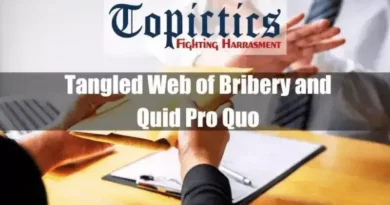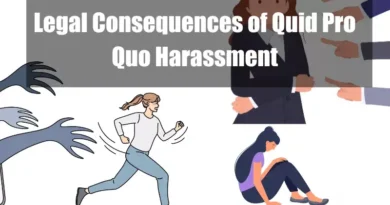MeToo Movement and Quid Pro Quo Harassment
Introduction
The #MeToo movement ignited a firestorm against sexual harassment, shining a light on “quid pro quo” abuse. This Latin term describes a situation where a superior offers a job benefit, like a promotion, in exchange for sexual favors. By bringing these stories to the forefront, #MeToo challenged power imbalances and pushed for workplace accountability.
Defining the MeToo Movement and Quid Pro Quo Harassment

The MeToo movement is a global movement against sexual assault and harassment, particularly in the workplace. The movement originated in 2006 with the phrase “Me Too” used by American activist Tarana Burke. However, it gained widespread recognition in 2017 after allegations of sexual misconduct against film producer Harvey Weinstein were made public. The movement encouraged women to come forward with their own experiences of sexual harassment and assault, breaking the silence surrounding these issues.
Quid pro quo harassment, a form of sexual harassment, occurs when an individual’s submission to or rejection of sexual advances affects their employment decisions. This can include situations where a person is promised a promotion, job, or other benefits in exchange for sexual favors or threatened with negative consequences, such as demotion or termination if they refuse. Quid pro quo harassment is an abuse of power and a serious violation of workplace rights.
Historical Context of the MeToo Movement and Quid Pro Quo Harassment

A. Early Instances of MeToo and Quid Pro Quo Harassment
The MeToo movement has its roots in earlier efforts to address sexual harassment and assault. In the 1960s and 1970s, the feminist movement brought attention to these issues, highlighting the experiences of women who had been silenced and subjected to abuse. Anita Hill’s testimony against Supreme Court nominee Clarence Thomas in 1991 further amplified the conversation about sexual harassment in the workplace.
The concept of quid pro quo harassment was developed in the 1970s with the passage of Title IX of the Education Amendments of 1972 and the Equal Employment Opportunity Act of 1976.
B. The Evolution of Social Norms and Legal Protections
Despite the historical recognition of sexual harassment and quid pro quo harassment, these issues have persisted due to societal norms that perpetuate gender inequality and power imbalances. The culture of silence surrounding these issues has also made it difficult for victims to come forward and seek justice.
In recent decades, however, there has been a significant shift in social norms and legal protections regarding sexual harassment. The MeToo movement has played a pivotal role in this shift by giving victims a voice, challenging societal norms, and demanding accountability from perpetrators. Legal protections have also been strengthened by introducing stricter workplace policies, anti-harassment laws, and enhanced enforcement mechanisms.
The Rise of the MeToo Movement
A. The Harvey Weinstein Allegations and the Spark of the Movement
The Harvey Weinstein allegations catalyzed the MeToo movement, propelling it into the global spotlight and igniting a wave of disclosures of sexual misconduct. The sheer volume of accusations against Weinstein, spanning decades and involving a powerful and influential figure, shattered the culture of silence that had long surrounded sexual harassment and assault.
The allegations also exposed the pervasive nature of quid pro quo harassment, highlighting the power imbalances that often enable such abuse. Weinstein’s alleged pattern of using his position and influence to coerce and pressure women into sexual relationships demonstrated the insidious nature of quid pro quo harassment and the devastating impact it can have on victims’ lives.
The public outcry following the Weinstein allegations was unprecedented. Women from all walks of life, including celebrities, activists, and everyday individuals, came forward with their own stories of sexual harassment and assault, using the hashtag #MeToo to share their experiences and break the silence. The movement’s reach extended beyond Hollywood, encompassing workplaces, schools, and communities worldwide.
B. The Global Impact of MeToo and Its Influence on Society

The MeToo movement’s impact has been profound and far-reaching, extending beyond the initial allegations against Harvey Weinstein and transforming the global conversation about sexual misconduct. The movement has:
1. Amplified the voices of victims:
The MeToo movement has given a voice to millions of survivors of sexual harassment and assault who have long been silenced and marginalized. By breaking the silence and sharing their stories, victims have empowered others to come forward, challenged societal norms, and demanded accountability from perpetrators.
2. Prompted institutional change:
The movement has spurred significant institutional changes, including stricter workplace policies, enhanced anti-harassment training, and stronger enforcement mechanisms. Organizations across various sectors have implemented new protocols to prevent and address sexual misconduct, creating safer and more equitable environments for all employees.
3. Influenced legal reforms:
The MeToo movement has also influenced legal reforms, strengthening laws against sexual harassment and assault. Legislators have responded to the movement’s demands by enacting stricter penalties for perpetrators, expanding the scope of workplace protections, and improving access to justice for victims.
4. Sparked broader conversations about consent, respect, and accountability:
The MeToo movement has ignited a broader conversation about consent, respect, and accountability in relationships, workplaces, and society. It has challenged harmful gender stereotypes, promoted a culture of respect and dignity, and encouraged individuals to take responsibility for their actions.
5. Empowered victims to seek support and justice:
The MeToo movement has empowered victims to seek support and justice, fostering a sense of community among survivors and encouraging them to come forward with their experiences. It has also created new resources and support systems for victims, providing them access to counseling, legal representation, and advocacy services.
The MeToo movement has undoubtedly transformed the global landscape surrounding sexual harassment and assault. By breaking the silence, empowering victims, and demanding accountability, the movement has sparked a global reckoning with sexual misconduct, challenging the status quo and paving the way for a more just and equitable society. It has reshaped the public discourse on consent, respect, and power dynamics, fostering a greater awareness and accountability culture. The movement’s impact has been felt across industries, institutions, and societies, prompting significant changes in workplace policies, legal protections, and social norms.

The Impact of MeToo on Quid Pro Quo Harassment
The MeToo movement has profoundly impacted the recognition and prevention of quid pro quo harassment. The movement has:
A. Increased Awareness and Recognition of Quid Pro Quo Harassment
The MeToo movement has brought quid pro quo harassment to the forefront of public consciousness, sparking a broader understanding of its pervasiveness and the power dynamics that enable it. By sharing their experiences, victims have helped to dispel misconceptions about quid pro quo harassment and encouraged others to come forward.
B. Changes in Workplace Policies and Legal Procedures
The MeToo movement has prompted organizations to re-evaluate their policies and procedures for addressing sexual harassment, including quid pro quo harassment. Many organizations have implemented stricter workplace policies, enhanced anti-harassment training, and strengthened reporting mechanisms to protect their employees better.
The MeToo movement has also spurred legal reforms, leading to stricter penalties for perpetrators, expanded protections for victims, and increased enforcement of anti-harassment laws. These changes have strengthened the legal framework against quid pro quo harassment, encouraging accountability and deterring future misconduct.
Challenges and Ongoing Efforts to Address MeToo and Quid Pro Quo Harassment
Despite the significant progress made in addressing quid pro quo harassment, challenges remain in fully eradicating this form of abuse. These challenges include:
- Addressing false accusations: While the MeToo movement has empowered victims to come forward, it is crucial to ensure that allegations of quid pro quo harassment are investigated fairly and that false accusations are not tolerated.
- Empowering victims and encouraging reporting: Victims may still face barriers to reporting quid pro quo harassment, such as fear of retaliation, disbelief, or concerns about job security. Ongoing efforts are needed to empower victims, protect them from retaliation, and encourage reporting.
- Implementing effective prevention and intervention strategies: Organizations must continue implementing effective prevention strategies, such as comprehensive anti-harassment training, clear reporting procedures, and strong leadership commitment. Intervention strategies, such as prompt investigations, appropriate disciplinary action, and support for victims, must also be robustly in place.
Conclusion
The MeToo movement has left an indelible mark on society, sparking a global dialogue about sexual harassment and assault, particularly in the workplace. The movement has transformed workplace culture by empowering victims to break the silence, challenging societal norms, and demanding accountability.
Organizations increasingly recognize the importance of fostering a safe, respectful, and equitable work environment for all employees. Stricter anti-harassment policies, enhanced training programs, and more robust reporting mechanisms have become the norm, reflecting a growing commitment to preventing and addressing sexual misconduct.
The MeToo movement has also fostered a culture of greater awareness and sensitivity towards consent, respect, and power dynamics. Individuals are more mindful of their behavior and more receptive to discussions about these issues, fostering a more inclusive and respectful workplace environment.
Despite the significant progress in addressing quid pro quo harassment, the struggle for a truly equitable and harassment-free workplace continues. False accusations, victim reluctance to report, and organizational challenges in implementing effective prevention and intervention strategies remain hurdles to overcome.
Ongoing efforts must focus on maintaining a balance between empowering victims and protecting the accused. Organizations should prioritize creating a workplace culture that values fairness, transparency, and respect, where individuals feel safe to speak up without fear of reprisal.
The MeToo movement has ignited a powerful movement for gender equality and social justice. By challenging harmful norms, empowering marginalized voices, and demanding accountability, the movement inspires positive change in workplaces, communities, and societies worldwide. Pursuing a world free from sexual harassment and assault remains a collective endeavor, requiring continued vigilance, education, and unwavering commitment to creating a just and equitable future for all.
FAQ
What is the MeToo Movement?
The MeToo Movement is a social campaign that aims to raise awareness about sexual harassment and assault. It began as a platform for survivors to share their personal stories, challenging the culture of silence and accountability. The movement has significantly influenced public discourse, workplace policies, and cultural attitudes worldwide.
When and how did the MeToo Movement begin?
The movement’s origins can be traced back to the early 2000s, but it gained global momentum in 2017 after high-profile revelations of sexual misconduct in the entertainment industry. Initially sparked by social media hashtags, the campaign empowered countless survivors to come forward, transforming personal experiences into a widespread call for change.
What impact has the MeToo Movement had on society?
The movement has profoundly shifted cultural norms and power dynamics, prompting industries to reexamine workplace conduct and implement reforms. Breaking the silence surrounding abuse has empowered survivors and sparked legal, social, and corporate changes. This momentum has led to greater transparency and accountability in various sectors across the globe.
Who are some key figures associated with the MeToo Movement?
Key figures include Tarana Burke, who originally coined the phrase “MeToo,” and numerous survivors, activists, and advocates who shared their stories. Prominent voices like Alyssa Milano helped amplify the movement through social media, highlighting systemic issues and encouraging broader discussions on sexual harassment and accountability.
How did social media contribute to the MeToo Movement?
Social media platforms played a critical role by providing a space for survivors to share their experiences anonymously and publicly. Hashtags like #MeToo created viral conversations, enabling solidarity and amplifying voices worldwide. This digital activism spurred media coverage, policy debates, and cultural shifts, fundamentally changing the way society addresses and understands sexual misconduct.
What industries have been affected by the MeToo Movement?
The movement has impacted multiple industries, including entertainment, media, politics, and business sectors. High-profile cases in Hollywood, the corporate world, and beyond have led to internal investigations, policy revisions, and increased scrutiny of workplace environments. These changes have helped foster safer, more accountable professional settings across various fields.
What legal changes have been influenced by the MeToo Movement?
The MeToo Movement has catalyzed legal reforms, including stricter workplace harassment laws, improved reporting procedures, and enhanced survivor protections. Legislators and institutions have reviewed existing policies, resulting in new regulations and legal precedents. These changes aim to create safer environments and ensure greater accountability for perpetrators of sexual misconduct.
What challenges has the MeToo Movement faced?
Despite its successes, the movement has encountered challenges, including backlash, accusations of overreach, and concerns about due process. Critics argue that some claims may be unverified, while others worry about the potential for false allegations. These debates highlight the complex balance between supporting survivors and ensuring fair legal processes.
How has the movement influenced workplace culture?
The MeToo Movement has significantly transformed workplace culture by prompting organizations to reexamine harassment policies, implement comprehensive training, and foster environments of transparency. It has encouraged employees to speak up against misconduct without fear of retaliation. This shift has led to stronger corporate accountability measures, creating safer, more respectful professional spaces for all workers.
What role have men played in the MeToo Movement?
Men have played multifaceted roles in the MeToo Movement. Some have taken responsibility for their past actions, publicly apologizing and advocating for change, while others have become allies, supporting survivors and promoting safer workplace practices. Their involvement has encouraged open discussions about masculinity, consent, and respect in both personal and professional settings.
How has the movement expanded globally?
The MeToo Movement has transcended borders, inspiring similar movements across different countries and cultures. Local adaptations have addressed unique challenges related to harassment and discrimination, while global social media platforms have facilitated shared experiences and collective action. This international momentum has underscored the universal need for safer, more respectful environments worldwide.
What criticisms has the MeToo Movement encountered?
Critics argue that the movement sometimes lacks due process, potentially tarnishing reputations without thorough investigations. Others express concern over false accusations and the impact on individuals’ careers. While many acknowledge its importance, these criticisms emphasize the need for balanced approaches that protect survivors while ensuring that legal processes and fair treatment for the accused are maintained.
How can individuals support the MeToo Movement?
Individuals can support the movement by educating themselves on issues of sexual harassment and discrimination. Sharing verified information, listening empathetically to survivors, and advocating for policy reforms in their communities are effective steps. Additionally, engaging in respectful discussions and promoting awareness can help create supportive environments and drive systemic change, reinforcing the movement’s goals.
What future directions are envisioned for the MeToo Movement?
Future directions include broadening the movement’s focus to address intersecting forms of discrimination and ensuring comprehensive support for survivors. Advocacy for policy changes, continued public dialogue, and improved legal safeguards remain priorities. The movement is likely to evolve by integrating more diverse voices and addressing systemic issues across various sectors, furthering societal progress.
How has the movement changed perceptions of sexual harassment?
The movement has fundamentally altered public perceptions by breaking long-standing taboos and encouraging open dialogue about sexual harassment. It has redefined social norms, shifting the focus from victim-blaming to accountability. This cultural transformation has led to more supportive environments for survivors and a broader societal commitment to confronting and preventing misconduct.









